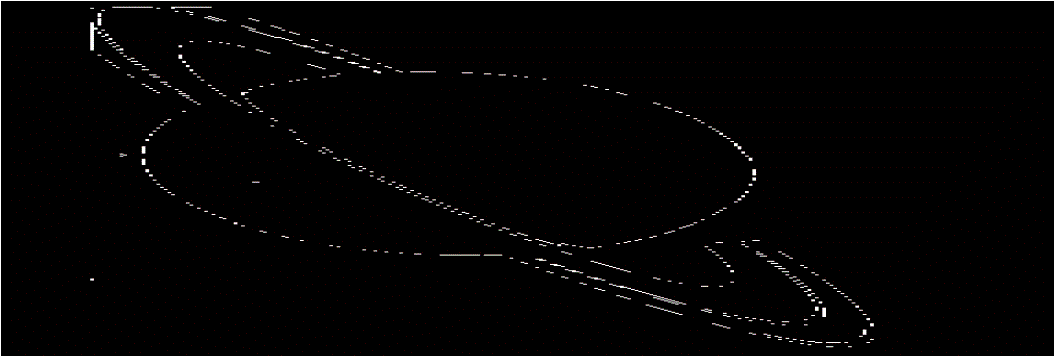Keywords
|
| Edge Detection, Fuzzy Logic, Fuzzy Inference System, Edges |
INTRODUCTION
|
| Edge detection is the name for a set of mathematical methods which aim at identifying points in a digital image at which the image brightness changes sharply or more formally has discontinuities. |
| Edge - The point at which image brightness changes sharply are typically organized into a set of curve line segments. Edge detection is a fundamental tool in image processing, computer vision particularly in the area of feature detection and feature extraction. The purpose of detecting sharp changes in image brightness is to capture important events and changes in properties of the world. |
| Edge Properties - The edges extracted for 2D images are viewpoint dependent. The viewpoint dependent edges may change as the view point changes, and typically reflect the geometry of the scene such as objects including one another. |
| Fuzzy Image Processing - Fuzzy image processing is the collection of all approaches that understand, represent and process the images, their segments and features as fuzzy sets. Process of Fuzzy Image processing is shown in Figure 1.The work of this paper is concerned with the development of fuzzy logic rules based method which can detect the edges of image. Fuzzy inference system in MATLAB environment has been developed which gives the output result of the input vector used as membership functions. |
LITERATURE SURVEY
|
| An Edge is not a physical entry, just like a shadow .It is where the picture ends and wall starts. It is where the vertical and horizontal surfaces of an object meet. It is what happens between a bright window and the darkness of the night[13].Traditionally edges have been loosely defined as pixel intensity discontinuities with in an image[2]. A large number of studies have been published in the field of image edge detection, which shows its importance in the field of image processing. Many edge detection algorithms are proposed, each of which has its own weaknesses and strength but we cannot say that a particular algorithm is best or not here we are emphasizing few of them. Most of them can be grouped into two categories search based and zero crossing based. Search based method used first derivative expressions such as gradient magnitude and zero cross methods used second order derivative expression computed from the image in order to find edges. Search methods such as „Robert?,?Sobel?,?Prewitt? have used 2D linear filters to produce vertical and horizontal edges separately to approximate first order derivatives of he image [2]. .All these algorithms are sensitive to noise , to solve these problem the canny edge detector was proposed which combines a smoothing function with zero crossing based method for edge detection.[12] the laplacian edge detection method has used a 2D linear filter to approximate second order derivatives of the pixel value of the image[2]. In another approach by Shannon entropy in which a threshold value is issued to segment and for binarization of the image then can find location and detection of the edges of the image.[14].Edges can be find using fuzzy logic algorithm with different levels of processing and threshold is set from slider control the resultant image from fuzzy is subjected to first and second derivatives to trace the edges of image.[3].Fuzzy based system are fast and provide good accuracy and this system is useful for image classification[4]. Edges can also be detected without determining threshold value [6]. Extended algorithm for edge detection using Shannon entropy is also developed which divide the image pixel into four sub regions all are worked separately for each pixel values [9].All these algorithm are successful for finding edges of the image but a good image edge detector must be able to detect edges of any type of images including noise removal algorithm. |
FUZZY LOGIC
|
| What is fuzzy logic? |
| Fuzzy logic is a logical system which is an extension of multivalued logic. In logics system multivalued logic is a propositional calculus in which there are more than two truth values. There are only two possible values true or false for any proposition but extension to classical two valued logic is an n-valued logic or n greater than two. |
| Why fuzzy logic? |
| Fuzzy logic is conceptually easy to understand and is flexible and is tolerant of imprecise data. Fuzzy logic is to map an input space to an output space and for doing this a list of if then statements called rules are evaluated in parallel .These Rules are useful because they use variables and adjectives that describes those variables. |
FUZZY INFERENCE SYSTEM
|
| Fuzzy inference system is a method that interprets the values in the input vectors and based on user defined rules, assigns values to the output vector. Using a GUI editors and viewers in the fuzzy logic toolbox, we can build the rules set, define membership functions and analyse the behaviour of a fuzzy inference system. The complete processing of Fuzzy inference system is shown in Figure 2.The editors and viewers are used to edit and view the membership functions and rules for fuzzy inference system. We can create the fuzzy inference system using GUI tool or command line function. |
FUZZY INFERENCE SYSTEM AS A CONTROLLER
|
| Design of fuzzy inference system is of four pixel values as input with one output pixel. Fuzzy sets – A fuzzy set is a set without a crisp, clearly defined boundary .In this paper we use pixel values of the image as fuzzy set with four input pixel values. We have taken values range from 0 -255 for four input pixel containing white and black color of the image. |
| Membership Functions – A membership function is a curve that defines how each point in the input space is mapped to a membership values (degree of membership) between 0 and 1.We have taken two membership function as two fuzzy sets for the input black and white colour of the pixel with pi shaped built in membership function range from [0 0 0 255] for black colour and range from [0 255 255 255] for white colour pixel as shown in Figure 3. |
| The membership functions for the output black ,white and edge of the output pixel with trapezoidal shape built in membership function range from [0 20 40 60 ] for black color and range from [100 120 140 160] for edge value and range from [195 215 235 255] for white color of the output pixel as shown in Figure 4. |
| If Then Rules - Fuzzy sets are the subjects and fuzzy operators are the verbs of fuzzy logic and if then rules are used to formulate the conditional statements that comprise fuzzy logic. A single fuzzy if then rule assumes the form if x is a then y is b, where „a? and b are linguistic values defined by fuzzy sets on the ranges x and y. The if part of the rule “x is a” is called “antecedent or premise” while then part of the rule “y is b” is called the “consequent” or “conclusion”. In this paper 33 if then rules are set for various conditions that can occur. B=black value of pixel, W=white value of pixel, E=edge output. |
| In this paper we are trying to find the neighbors of the pixel (X, Y) using 8 connected approach in which directions are changed for practical changes. We are proposing all its 8 neighbors and original pixel (X, Y). P1=(X-1, Y+1), P2=(X, Y+1), P3=(X+1, Y+1), P4=(X-Y), P5=(X, Y), P6=(X+1, Y), P7=(X-1, Y-1), P8=(X, Y-1) & P9=(X+1, Y-1) of the original or current pixel value. |
DEFUZZIFICATION
|
| Defuzzification is a process of producing a quantifiable result in fuzzy logic , for given fuzzy sets and corresponding membership degrees. These will have a number of variables into a fuzzy result. The result is described in terms of membership in fuzzy sets. |
| There are five methods for defuzzification. |
| In this paper for defuzzification we used middle of maximum method. The input for the defuzzication is a fuzzy set (the aggregate output of fuzzy set) and the output is a single number. |
| A. Centroid Method |
| B. Bisectors Method |
| C. Middle of Maximum Method |
| D. Smallest of Maximum Method |
| E. Largest of Maximum Method |
| In this paper for defuzzification we used middle of maximum method. The input for the defuzzication is a fuzzy set (the aggregate output of fuzzy set) and the output is a single number. |
EXPERIMENTS
|
| The simulation result for fuzzy inference system for input pixel values taken randomly and generated output of the fuzzy inference system after defuzzification. Reading the fuzzy inference system by using readfis( ) function in MATLAB environment. |
| >> a=readfis(„edge.fis?) and Output is evaluated by using evalfis function. >>evalfis([i1,i2,i3,i4,i5,i6,i7,i8,i9],a) The proposed method has been applied in MATLAB environment on the images of “1.jpg” in Figure 5, “saturn.png” in Figure 6. The results for these images can be seen in Figure 7, Figure 8, respectively. It can be seen from the results that the proposed method is able to find out thin, clear edges. |
CONCLUSION
|
| In this paper , we have developed fuzzy inference system with nine input pixel containing two fuzzy sets one for white and another for black and one output pixel containing three fuzzy sets first for white second for black and third for edge. Fuzzy inference system is developed successfully which can detect edges of images for fuzzy set and apply defuzzification of the output generated by fuzzy inference system. Experimental results are displayed in figures. |
| |
Tables at a glance
|
|
|
| |
Figures at a glance
|
 |
 |
 |
 |
| Figure 1 |
Figure 2 |
Figure 3 |
Figure 4 |
|
=
 |
 |
 |
 |
| Figure 5 |
Figure 6 |
Figure 7 |
Figure 8 |
|
| |
References
|
- www.mathwork.com
- Rafael C.Gonzalves and Richard E Woods “Digital Image Processing “Third Edition 2009.
- Fuzzy Logic Based image edge Detection Algorithm in Matlab International Journal of computer Applications (0975-8887) Volume I No22.
- Manish Sharma ,RashmiGupta,Deepak Kumar and Rajeev Kapoor.”Efficacious approach for satellite image classification”. Journal ofIEEE Engineering, Vol. 8, 866-883.
- Adel Abdennour,Electrical Engineering Department King saud University “Tutorial on fuzzy logic using MATLAB”
- Suryakant,Neetukushwaha” Edge Detection in fuzzy logic in MATLAB”.Internatonal Journal of Advanced research in computer scienceand software engineering.
- S.N.sivanandam,S.sumathi,S.N.Deepa.”Introduction to fuzzy logic using MATLAB”
- Mr.DibakarPal.”Image processing through Fuzzy Logic”
- Mohamed A.El-Sayed et al “New Edge Detection Technique Based on the Shanon Entropy in Gray level Images” Internationa Journal onCSE(IJCSE).
- Sabina priyadarshini and gadadharsahoo . “A new edge detection method based on additions and Divisions”.International Journal ofComputer Applications(0975-8887) Volume 9 –No 10 November 2010.
- “A fuzzy logic based method for edge detection” Buletinn of the Transilvania University of Brasov.Vol 4(53) No1 1-2011.
- John canny member IEEE “A Computational Approach to edge detection” volpami -8 no 6 November 1986.
- www.edgedetection.html
- Amar pratap Singh and BaljitSingh.”Edge Detection on Gray Level Images based on Shanon Entropy”. Journal of CS 01, 2008
|